Google LookML-Developer Looker LookML Developer Exam Online Training
Google LookML-Developer Online Training
The questions for LookML-Developer were last updated at Apr 21,2025.
- Exam Code: LookML-Developer
- Exam Name: Looker LookML Developer Exam
- Certification Provider: Google
- Latest update: Apr 21,2025
The code below shows a vieworder_items with its measures total_revenue and user_count
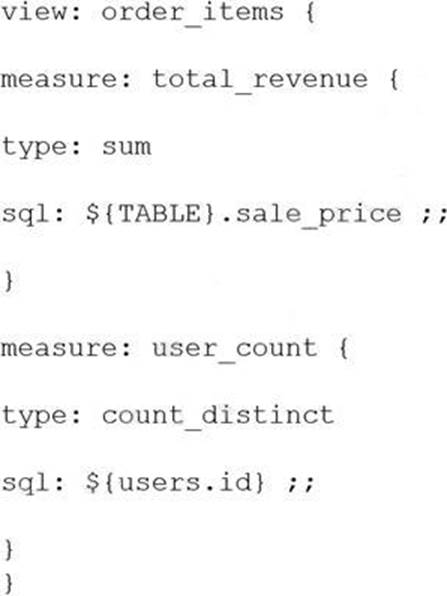
Which code correctly represents a new measure that calculates average revenue per user?
A)
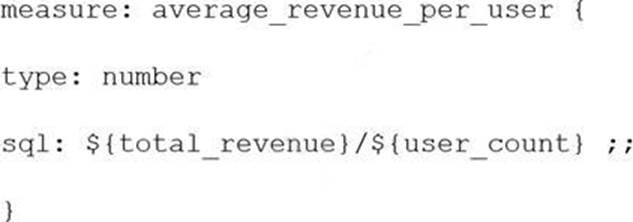
B)
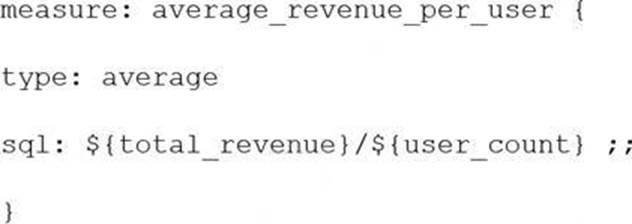
C)
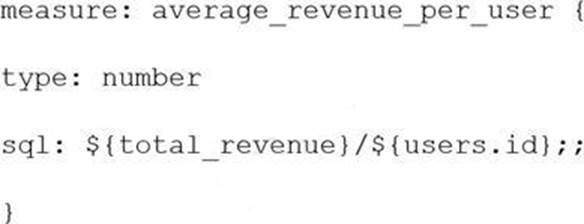
D)

- A . Option A
- B . Option B
- C . Option C
- D . Option D
A user needs to create a report that shows a count of all orders and of orders over $100.
Which solution should the developer implement to meet these requirements?
- A . An always_filter parameter
- B . A front-end filter in the Explore
- C . A sql_always_where parameter
- D . A filtered measure
A LookML developer builds a view that contains sensitive information. Only members of the Management group should have access to the view. The developer needs to restrict the view from appearing in the field picker for any Explore where it might be joined for users outside of the Management group.
Which LookML parameter should the developer use to meet this requirement?
- A . access_grant
- B . always_filter
- C . access_filter
- D . sql_always_where
A
Explanation:
Reference: https://docs.looker.com/admin-options/tutorials/permissions
A developer wants tocreate a measure that shows the item count broken out by category. When a second, more granular dimension is added to the same query, the count broken out by category should still represent the original aggregation and be duplicated on each line. The business wants this “count” in “category” available in the Explore section without any additional work done by the end user.
For example:
The Count column represents the count for each combination of Category and Item.
The Count in Category column represents the count for each Category only.

How can the developer address this need with a LookML object?
- A . Create a measure filtered on Category, and make the filter value controlled by a parameter.
- B . Calculate the measure using a derived table, and then join that derived table back into the Explore.
- C . Create a measure with type: sum_over_dimension, and make the dimension value controlled by a parameter.
- D . Calculate the overall count using table calculations in the Explore.
A user reports that, when a date dimension is filtered to “before now” results are returned that consistently include tomorrow. Dimension fill has been ruled out as a cause of the issue.
Which LookML parameter should be used to resolve this issue?
- A . Week_start_day
- B . Convert_tz
- C . Datatype
- D . Fiscal_month_offset
A developer needs to model out LookML to convert existing reports into Looker.
The existing reports are:
Report 1: A report with order and order_items data, which finds the order with the largest total value of the order_item prices.
Report 2: A report with order and order_items data, which finds the order with the largest total number of products ordered.
Report 3: A report with data on every product, whether or not it has been ordered.
Each database table used is updated in real time as orders are made.
How should the developer construct an Explore using the order_items view as the base view?
- A . Create one persistent derived table to calculate Report 1, create one persistent derived table to calculate Report 2, and join in the products view with a full_outer join.
- B . Create one persistent derived table to calculate Reports 1 and 2, and join in the products view with a full_outer join.
- C . Create one ephemeral derived table to calculate Report 1, create one ephemeral derived table to calculate Report 2, andjoin in the products view with a left_outer join.
- D . Create one ephemeral derived table to calculate Reports 1 and 2, and join in the products view with a full_outer join.
A developer has User Specific Time Zones enabled fora Looker instance, but wants to ensure that queries run in Looker are as performant as they can be. The developer wants to add a datatype: date parameter to all dimension_group definitions without time data in a table-based view, so that time conversions don’t occur for these fields.
How can the developer determine to which fields this parameter should be applied through SQL Runner?
- A . Open the Explore query in SQL Runner and validate whether removing the conversion from date fields changes the results.
- B . Open the Explore query in SQL Runner to determine which fields are converted.
- C . Use the CAST function in SQL Runner to ensure that all underlying fields are dates and conversions are not applied.
- D . Use the Describe feature in SQL Runner to determine which fields include time data.
C
Explanation:
Reference: https://community.looker.com/technical-tips-tricks-1021/how-looker-does-timezones-and-how-to-troubleshoot-them-25477
A developer defines the following measure in the order_items view:

The code must validate without errors.
Which action should thedeveloper take?
- A . Join order_items and inventory_items in a derived table.
- B . Join order_items and inventory_items in the same Explore.
- C . Copy the cost definition from inventory_items to the order_items view file.
- D . Add the following to the order_itemsview file: include: “inventory_items,view.lkml”
A developer is building an e-commerce Explore with the following datasets: orders and users. The business user needs to be able to answer questions about sellers and buyers within the same Explore. Each order in the orders table reports a buyer and seller ID. The users table has the detailed information about the individual buyer and seller.
How should the Explore be defined to meet this requirement?
A)
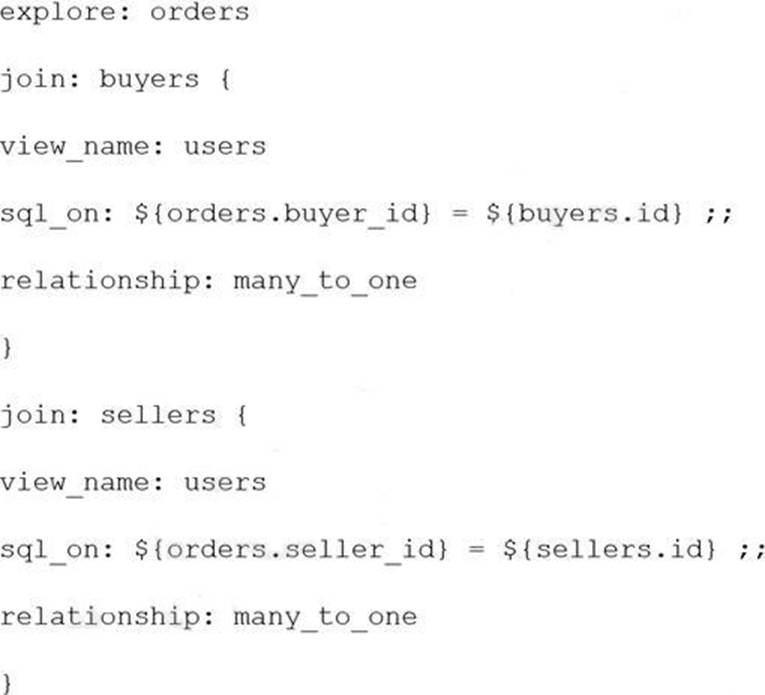
B)
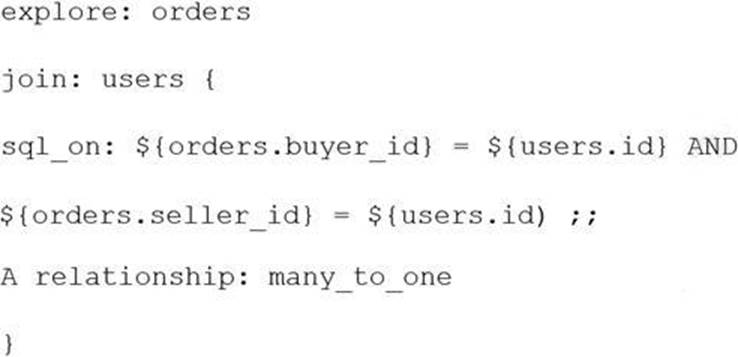
C)
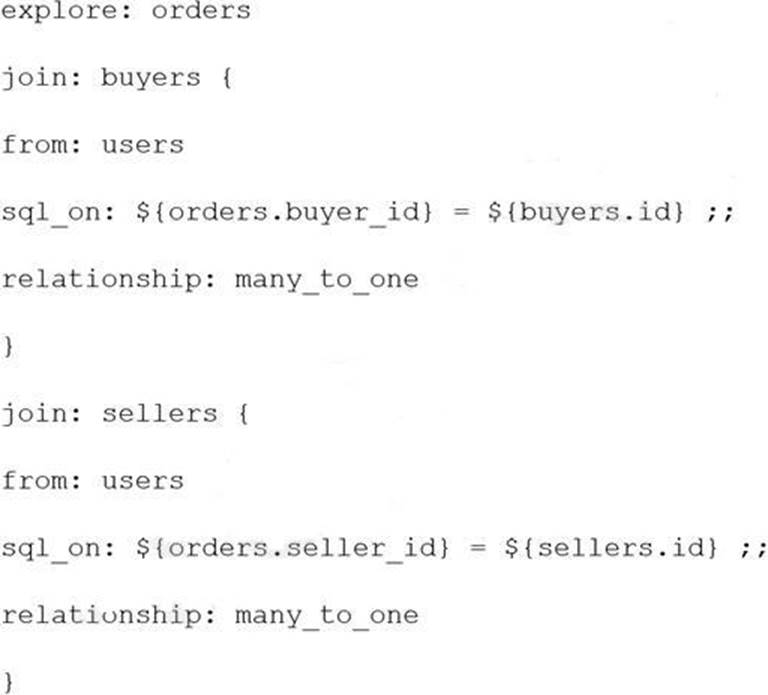
D)
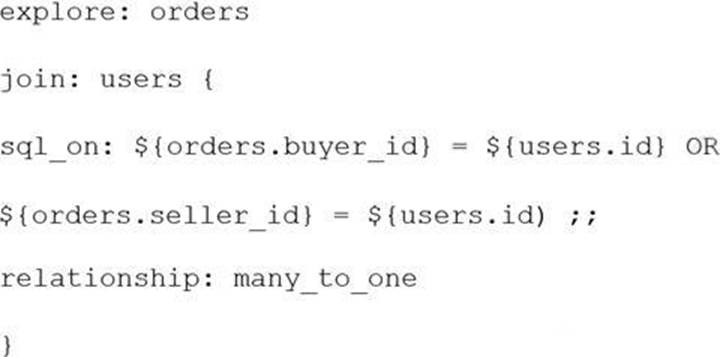
- A . Option A
- B . Option B
- C . Option C
- D . Option D
A user is seeing an error in the Explore that indicates the primary key defined for a one- million-row table is not unique.
How can the developer use SQL Runner to troubleshoot quickly?
- A . Create a query that selects all the fields from the table, and sort by primary key.
- B . Create a query that selects the primary key from the base view, and look forduplicates.
- C . Create a query that counts how many occurrences of the primary key value are in the base view, and sort by count.
- D . Create a query that concatenates two columns to create a compound primary key.
D
Explanation:
Reference: https://help.looker.com/hc/en-us/articles/360037732513-Error-Non-Unique-value-primary-key-or-sql-distinct-key-value-overflow-or-collision-when-computing-sum
Latest LookML-Developer Dumps Valid Version with 50 Q&As
Latest And Valid Q&A | Instant Download | Once Fail, Full Refund

